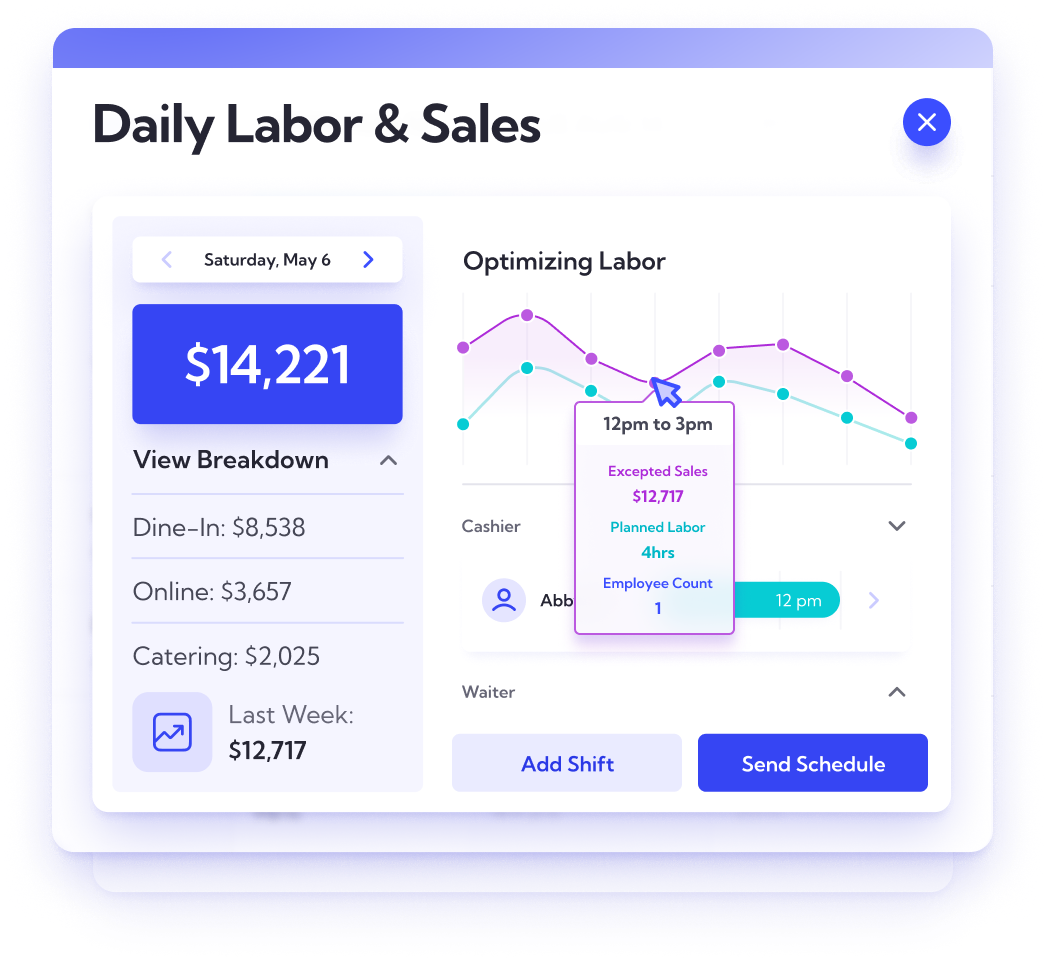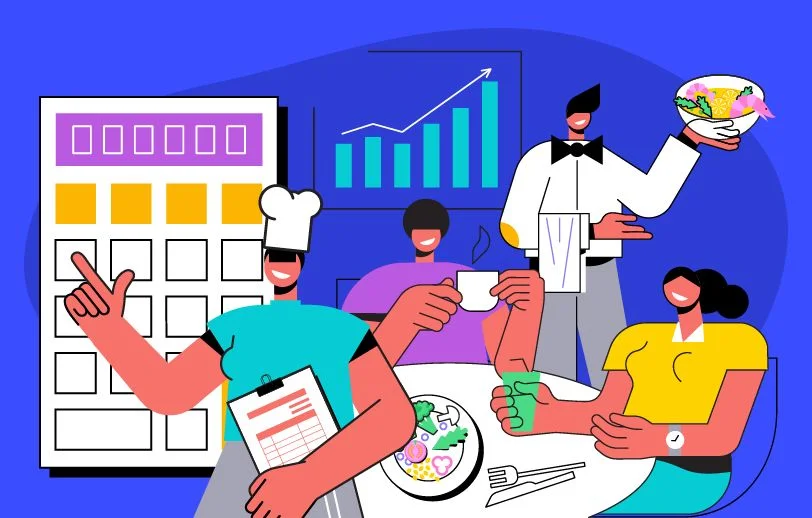Experts say the optimal table turnover time is around 45 minutes. However, for most restaurants, average table turnover rate is 3.
More tables mean more money, but you don't want to rush your guests.
In this guide, we’ll explain what table turnover rate is and how you can calculate it, as well as go over four strategies you can use to improve the table turnover rate at your restaurant.
What is Table Turnover Rate?
Table turnover rate (TTR) is an important restaurant metric that shows how fast your restaurant can turn tables, i.e., serve multiple guest parties at the same table one after the other, typically during a meal service like lunch or dinner.
The faster your restaurant can turn tables, the more revenue you can generate. As such, table turnover rate has a direct impact on your restaurant’s profitability.
How To Calculate Table Turnover Rate
To calculate your table turnover rate, start by choosing a period of time (e.g., dinner). Then, track how many guest parties you serve during that period.
Divide the number of parties served by the total number of tables. The result is your table turnover rate.

Step 1: Determine the Time Period
Decide on the specific time period for which you want to calculate the turnover rate. This could be a specific service (like dinner or lunch), a full day, or even a longer period like a week or month.
Step 2: Step 2: Count the Number of Parties Served
Tally the total number of parties (or groups of customers) that were served during the chosen time period. Ensure that every party that occupies a table is counted, regardless of the size of the party.
Step 3: Determine the Number of Tables
Determine the total number of tables available in your restaurant during the same time period. This should include all the tables in your dining area.
Step 4: Plug the Numbers Into the Formula
The table turnover rate is calculated by dividing the total number of parties served by the number of tables available.
Example:
If your restaurant served 120 parties in one day and you have 30 tables, the calculation would be:
Table Turnover Rate = 120 / 30 = 4
This means, on average, each table was turned over four times during the specified time period.
Understanding the Results
As mentioned, the average table turnover rate in the restaurant industry is 3. A higher table turnover rate indicates that your restaurant is serving more customers per table, which can be a sign of good efficiency and potentially higher revenue. However, it's important to balance turnover with customer satisfaction, as rushing guests can lead to a negative dining experience.
If your current table turnover rate is lower than 3, check out the tips in the next section to improve it.
Remember that the table turnover rate is just one restaurant metric and should be considered along with other factors like customer satisfaction, service quality, and overall revenue to assess the efficiency of your restaurant operations.
4 Ways To Improve Table Turnover Rate
As a restaurant owner or manager, some of the best ways you can improve table turnover rate include limiting menu size, avoiding serving incomplete parties, letting customers order before arriving, and optimizing the layout of the dining area.
1. Limit Menu Size
In the past, restaurants tried to attract guests with a large list of menu items. This has started to change in recent years, with a lot of restaurant businesses understanding the benefits of having a smaller menu.
A smaller menu makes it easier for customers to decide on a dish. It prevents decision fatigue and speeds up the ordering process.
Making your menu smaller has other benefits, as well. It means having fewer inventory items to manage and makes it easier to train new employees.
Additionally, having your kitchen staff focus on a smaller number of menu items will result in higher-quality dishes overall. This, in turn, will help improve customer satisfaction in your restaurant.
So, how many items should you include on your menu? While there’s no scientific answer here, having 7-10 items per category (appetizers, main dishes, desserts, etc.) is often recommended.
If your menu has more items than that per category, you should look into potentially removing a few of your worst-performing items from the menu.
2. Avoid Serving Incomplete Parties
When you seat incomplete parties, one of two things will happen:
- You’ll have to take orders twice (once for the part of the group that arrived on time, and a second time for the latecomers).
- The people who arrive on time will wait for their friends to arrive before ordering.
In both situations, the dining experience will be prolonged, and the table will be occupied for longer than it should be, increasing wait times for other guests. This can reduce your table turnover rate significantly and eat into your restaurant’s profits.
Additionally, sometimes the would-be latecomers never arrive at all. As a result, you might have to turn away a bigger walk-in party of guests because you’ve seated a smaller party at a bigger table.
To avoid this, institute a policy of not serving incomplete parties at your restaurant. Make sure to let guests know about this policy when they make a reservation, though.
3. Offer Guests the Option To Order Ahead Of Time
Having customers decide on a dish and then taking their order can often take up to 15 minutes. What if you could speed up this process significantly?
This is what online ordering solutions like GloriaFood and TellTheChef allow you to do.
By letting customers order ahead when they make an online reservation or reserve a table by phone, they can decide what they’ll have before arriving. This has multiple benefits:
- It’s more convenient for customers, as the food will be ready for them when they arrive.
- It reduces your front-of-house staff’s workload and makes their life easier on the busiest of nights.
- It streamlines your back-of-house staff’s work by letting them know in advance which dishes they need to prepare. This also means less stress, which results in better dishes and happier staff.
4. Set a 90-Minute Table Time Limit
Table time limits are not new. Restaurants have been implementing them for a while.
These types of limits have become especially common during the pandemic, when restaurants used them to account for reduced seating capacity that was a result of the COVID-19 safety measures.
Setting a table time limit can be a good way to avoid having guests linger at a table for too long after they’re finished eating. It can also help you ensure a high table turnover rate.
The average restaurant that implements this type of time limit gives guests 90 minutes to enjoy their meal.
If you decide to implement a table time limit, make sure to let guests know about the limit when they make a reservation.
It’s also a good idea to have the server remind guests about the limit when they first sit down, as well as give them a reminder 30 minutes before their time is up.
PRO TIP: Restaurant forecasting software like Lineup.ai can significantly impact the Table Turnover Rate (TTR) in a restaurant by providing valuable insights and streamlining various processes. Here's how Lineup.ai and similar tools can help improve TTR:
- Accurate demand forecasting: These software solutions use historical data, current trends, and other factors to predict customer demand accurately. By knowing how many guests to expect during specific time frames, restaurants can better manage reservations, staffing, and resources to optimize table turnover.
- Anticipating seasonal and trend changes: Forecasting tools can help restaurants prepare for seasonal changes or sudden trends. Being proactive in adjusting operations based on anticipated shifts in demand ensures smoother service and higher table turnover.
- Efficient staff scheduling: With insights from the forecasting software, restaurant managers can schedule the right number of staff members at peak times, ensuring efficient service without unnecessary overstaffing. Proper staffing levels help in serving customers promptly, thus increasing table turnover.
- Menu and pricing optimization: Forecasting software can also analyze the impact of different menu items and pricing strategies on customer choices. Restaurants can adjust their menus to offer popular and faster-to-prepare dishes during busy periods, enabling quicker table turnover.
Learn more about how Lineup.ai works.

Boost Your Restaurant’s Table Turnover Rate
If you got this far, you’ve probably learned how to calculate table turnover rate easily. As for improving table turnover rate at your restaurant, you can try out these strategies to serve a higher number of customers in the same amount of time without damaging the guest experience:
- Limit the size of your menu to prevent decision fatigue and help guests choose a dish in less time.
- Let guests know that you don’t serve incomplete parties when they’re making a reservation.
- Offer the option to order ahead to improve satisfaction for your guests and staff.
- Set a 90-minute table time limit to prevent guests from lingering at their table for too long.
If you’re looking for more great restaurant management content to help you improve your restaurant’s bottom line, check out these guides:

Boris Mustapic is a content marketer with a decade of experience in the digital marketing industry. He specializes in helping B2B SaaS companies drive growth through strategic, product-led content marketing.
More about the author